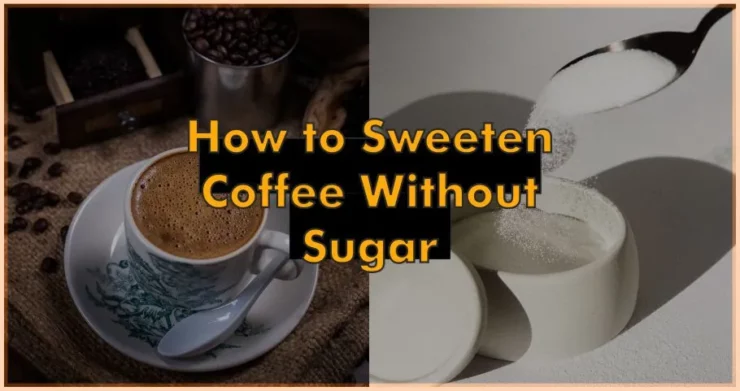One of the first things people do when they want to lose weight is cut back on sugar. However, many of us add sugar to the coffee. Coffee is an important part of breakfast and daily life for most Americans.
Using something to sweeten coffee without sugar can have some advantages. For instance, it might have a lower glycemic index and be better for the level of blood sugar in your body. You’ll also get to try some great new combinations of flavors.
However, because everyone’s health is unique, it is always essential to conduct thorough research. Even though the items on this list are natural and will be less developed than white sugar, that doesn’t mean they are better for your health.
There are other healthier and lower-calorie ways to sweeten your coffee. Here are different easy and cheap methods how to sweeten coffee without sugar.
32 Ways to Sweeten Coffee without Sugar
- Sugar-Free Coffee Syrups
- Vanilla Extract
- Honey
- Mint
- Unsweetened Vanilla Almond Milk
- Stevia
- Erythritol
- Cinnamon
- Unsweetened Cocoa Powder
- Agave
- Salt
- Maple Syrup
- Plant-Based Milk
- Molasses
- Coconut Sugar
- Monk Fruit
- Brown Sugar
- Chocolate Chips
- Date Sugar/ Syrup
- Sweetened Condensed Milk
- Beet Sugar
- Vanilla Ice cream
- Artificial Sweeteners
- Butter or Coconut Oil
- Yacon Syrups
- Half a Banana
- Creamer
- Apple Syrup
- Amasake
- Grape Syrup
- Mesquite Powder
- Xylitol
1. Sugar-Free Coffee Syrups
Since sucralose, a natural sweetener to sweeten coffee without sugar made from regular sugar, is used in Skinny Mixes syrups, they don’t contain any artificial or additive ingredients.
Each syrup has no carbs, sugar, or fat, and it tastes great in a hot cup of espresso, a protein shake, a smoothie, or an iced tea.
The Sugar-Free Chai Syrup will blow your mind if you want a velvety Chai Latte. It’s sugar-free, kosher, keto-friendly, and gluten-free and has a gorgeously smooth finish.
2. Vanilla Extract
Adding vanilla extract to your favorite beverage is one of the effective ways to sweeten coffee without sugar. Even though it doesn’t have any sugar, it tastes sweet. Start with half a teaspoon and see how it tastes.
3. Honey
Honey in coffee is good for your health in ways that black coffee isn’t. The superfood protects cells from damage, kills germs, and reduces inflammation.
Honey can help with several health problems and speed up the healing of wounds. It’s easy on your stomach and gives you more potassium and magnesium.
But you should only use a little squeeze of honey. You don’t want to change the taste of your healthy coffee too much or add calories you don’t need. Honey has more calories per serving than brown or white sugar, but those calories come from a healthier source.
4. Mint
Mint naturally has a sweet flavor and pairs nicely with coffee, much like vanilla. You can put fresh mint leaves in your coffee or mix a small amount of mint extract.
5. Unsweetened Vanilla Almond Milk
Many kinds of vanilla almond milk have sugar added to them, but even the ones that don’t may add a nice sweetness to your coffee. When you mix the flavor of vanilla with the smoothness of almond milk, you get a delicious cup of coffee.
6. Stevia
Stevia might look like other artificial sweeteners, but it is a natural sugar replacement. The stevia plant is where Stevia comes from. After some chemical processing, it becomes the packets you see in stores.
Using Stevia makes it less likely that your blood sugar will spike or you will gain weight. It has no calories, so people who want to cut back on empty calories often use it to sweeten their coffee.
7. Erythritol
Like other polyols, erythritol is a sugar alcohol from plant carbohydrates. Like Stevia, erythritol must undergo a chemical change before it can be used as the zero-calorie sweetener that many people with diabetes and people trying to lose weight like.
It’s also a better sweetener than Xylitol, which can cause gut problems if you eat too much. For the sake of your stomach, if you’re already looking for low-acid coffee, stay away from sweeteners that can upset it.
8. Cinnamon
The link with sweetness may deceive your taste senses even when spices like cinnamon aren’t genuinely sweet. It can taste sweeter if you add a pinch of cinnamon to your morning coffee if you associate it with pancakes, Mexican chocolate, and snickerdoodles.
Try the Spiced Cookie Gold Coffee from Golden Ratio if you enjoy spiced coffee. Vanilla, cloves, and cinnamon combine to make the ideal confectionary flavor.
9. Unsweetened Cocoa Powder
Don’t want sugar in your mocha? Add some unsweetened cocoa powder to your coffee. You may still experience all the delicious chocolate flavors without the added calories.
Cocoa powder boosts the immune system and reduces pain and inflammation naturally. It also makes you feel better to sweeten coffee without sugar. Some cocoa flavor may already be present in your coffee if you use protein powder.
10. Agave
A popular sweetener used in anything from baked products to brewed coffee, agave syrup, or nectar originates in Mexico. For those who want to avoid coffee bitterness and acidity, caramel is an excellent option.
Agave is preferable to table sugar since it has a lower glycemic index and prevents insulin rises. But if you are sensitive to fructose, use agave sparingly. The nectar has more sugar than high fructose corn syrup, even though it’s natural.
Also Read: How Coffee Makers Work in Different Cases
11. Salt
It seems strange to put salt in something to make it sweeter, but it works! Your cup of coffee may taste less bitter and allow you to taste its sweeter side if you add a bit of salt to it.
12. Maple Syrup
A teaspoon of maple syrup can sweeten coffee if you’d rather use natural sugar. The less-processed sugars give intriguing flavors to your coffee and are simpler for your body to digest. Honey is sweeter than white sugar, so you may use less and still get a delicious cup.
13. Plant-Based Milk
Almond milk is one example of plant-based milk that can subtly sweeten coffee without sugar substitutes. You’ll get a nuttier flavor in conventional coffee sweeteners and creamers without the natural sugar.
Like your coffee with a hint of vanilla? Try plant-based milk that has a flavor. This “sweetener” is also best to put in a cold brew.
14. Molasses
Coffee drinkers who prefer strong, dark flavors like mocha or dark coffee should opt for thick, syrupy molasses. Molasses, however, is not the best option if you want a cup that tastes smoother because it is earthy and a touch bitter.
Cane sugar and sugar beets are both used to create molasses. During refining, the sugar’s juice is taken out and boiled to make molasses, which is less healthy than refined sugar. Molasses that is dark or “bootstrap” has the most antioxidant power.
15. Coconut Sugar
If you enjoy using coconut milk and oil in your cooking, adding coconut sugar to your morning cup of coffee may seem like a natural step. You should use coconut sugar sparingly, though. Even though it comes from natural sources, it has a lot of fructose.
Depending on the brand, this one also has a slight coconut aftertaste. If that sounds perfect, go ahead and sprinkle.
16. Monk Fruit
Monk fruit extract, which is very sweet, can be used by people who drink coffee as a natural sugar substitute. Since the extract is up to 200 times sweeter than table sugar, only a small amount is needed to make a big difference.
Manufacturers prepare it by removing the fruit’s peel and fleshy residual portions, known as MoGro sides, and mashing them. The extracted substance is where the sweetness, free of calories, comes from.
There are no calories or fat in monk fruit. Compared to white sugar and synthetic coffee sweeteners, it is friendlier on the digestive system. This tasty sugar alternative is a great addition if you like low-acid coffee but want a softer cup in the morning.
17. Brown Sugar
Brown sugar has a rich, distinct taste, but it’s still sugar, so it’s pretty easy to use instead of white sugar. When you switch, use less of the darker ones because they have more flavor.
18. Chocolate Chips
If you use chocolate chips that have been sweetened, your black coffee will turn into a delicious latte. Chocolate Chips are a good alternative to sweetening coffee without sugar.
19. Date Sugar/ Syrup
Dates are dried out and ground into granules to make sugar. This may end up leaving a little bit of grit in your cup. The juice from the dates is cooked, filtered, and then heated once more to thicken it into syrup.
Date sugar has a GI of 44–55, lower than white sugar’s 65. It also has many good things, like fiber, potassium, and iron, but not enough to make a big difference. Some of the nutrients are lost when heat is used to make syrup.
One teaspoon of honey has 15 calories, while one teaspoon of sugar has 16. With 18 calories, the syrup has more than the other two. It tastes like brown sugar mixed with butterscotch.
20. Sweetened Condensed Milk
You’ll get a nice creamer at the same time! But be careful with amounts because sweetened condensed milk is usually very rich.
21. Beet Sugar
Beets are cut into pieces to extract the juice, which is then boiled, filtered, and condensed into syrup. The syrup has turned into granules because it has crystallized.
Beet sugar is so similar to white sugar, according to this article, that you might decide not to use it. Sugar beets account for 55%-60% of America’s sugar supply. Its GI of 61 is not significant.
Since bone char is not used in its production, if you’re concerned about animal products, you might prefer this to white sugar. One teaspoon of honey has 15 calories, while one teaspoon of sugar has 16. It tastes and smells like white sugar, but the aftertaste and smell are not as nice.
22. Vanilla Ice cream
This one does sound a little crazy. But if you stop and think about it, ice cream is just milk with flavoring, and a sweetener added. So, putting a dollop of vanilla ice cream in your coffee will make it sweeter and give it a nice flavor.
23. Artificial Sweeteners
If you want to lose weight and eat less sugar, switch to an artificial sweetener. You won’t need quite as much as you would with regular sugar because these are 200–600 times sweeter.
Choose an artificial sweetener that tastes good to you. Some people find that artificial sweeteners like Splenda leave them with a bitter or metallic taste in their mouths.
Xylitol, sorbitol, erythritol, and sorbitol are low-calorie alternatives to artificial sweeteners. Sugar alcohols are found naturally in plants, but most products are made in a lab.
24. Butter or Coconut Oil
Coffee prepared with butter or coconut oil won’t be as sweet as coffee prepared with sugar, but the bitterness will be lessened, and the coffee’s flavor will be more well-rounded. Blend coconut oil or unsalted butter into your coffee with a spoon.
Butter or coconut oil’s fatty components will rise to the top of the brew. If you have a milk frother, blend it in the coffee, so the fats mix.
25. Yacon Syrups
Yacon syrup, made from the plant’s tubers, is mostly oligofructose and inulin and has fewer calories than sugar. Since inulin doesn’t change the amount of sugar in the blood, people with diabetes may also be interested in this sugar substitute.
Because oligofructose only has a sweetening potential of 30–50%, Yacon syrup is not as sweet as regular syrups, honey, or sugar. It complements a variety of sweet and savory recipes with its smooth, fruity, and caramelized flavor.
26. Half a Banana
You’ll need a blender for this one, but you won’t be sorry. Make a quick smoothie that tastes great on its own or with a bowl of oatmeal in the morning.
Bananas also give your morning cup a boost of nutrients, like potassium, which helps muscles work, and vitamin B6, which keeps nerves healthy.
27. Creamer
Coffee can taste less bitter by adding milk, cream, or plant-based creamer and stirring it in. If you prefer plant-based alternatives, look for unsweetened selections with an additive taste, such as soy vanilla creamer.
Whole milk or half-and-half has more fat than low-fat and skim milk, so they taste sweeter by nature.
Also Read: How To Make Coffee Creamer
28. Apple Syrup
Another item to sweeten coffee without sugar, however difficult to locate, is apple syrup, which is very digestible, high in vitamins and minerals, and ideal for enhancing pastries. This is a good alternative to sweeten coffee without sugar.
29. Amasake
AMASAKE is a different natural sweetener that is frequently used in Asian cooking. It can be easily made at home and is delicious when served as a dessert. White rice undergoing an enzymatic germination procedure is the basis for AMASAKE.
It is a natural sweetener that comes from Japan. Cereals like rice, oats, and millet are fermented to make them.
The koji mushroom is a microorganism that breaks down the beans’ starch into simpler sugars. You can eat it straight up or use it to make puddings and spoon sweets; it tastes sweet and has the texture and flavor of thick spaghetti.
30. Grape Syrup
It comes from boiled and pressed grapes, then spiced with cloves, cinnamon, and lemon. It has fructose and a unique taste that not everyone likes.
31. Mesquite Powder
American carob or mesquite powder, which is made from the beans of the tree of the same name, has a naturally sweet flavor and a low Gl.
The only places you can find the long-pod plant are in dry parts of northern Mexico and the southwestern United States.
Native Americans have always used the powder made from it as food. Today, you can find it in some specialty shops and online, but it’s still not very common.
Fructose and soluble fiber, two ingredients in mesquite flour, allow for slow absorption of other sugars and nutrients without experiencing glycemic peaks.
You can use it instead of refined flour in the dough, which means you won’t need as much or any extra sugar.
32. Xylitol
Natural sweetener xylitol is also known as “birch sugar.” It can be found in vegetables, fruits, and the bark of some trees, like birch and beech.
Xylitol is made from hardwood xylans, corn cob scraps, straws, or cereal bran through a complicated process. Because it costs a lot to make, birch sugar can be used instead of expensive sugar. Its sweetening power ranges from 98% to 100%.
It tastes sweet, like regular sugar, and cools the tongue a little bit. Birch sugar can be used as table sugar or to make chewing gum and sweets with no added sugar.
Xylitol is generally well tolerated. However, switching from regular sugar to Xylitol can make you have diarrhea, especially in the beginning and when you eat a lot of it. Some animal species can’t handle it at all.
To sweeten drinks and foods, of course, but also to cook with and preserve jam, birch sugar has many uses. Xylitol stops yeast from growing, so it’s best not to use it in doughs that are supposed to rise.
Also Read: Coffee Maker Cyber Monday Deals 2022
Benefits of Sweeten Coffee without Sugar
To make your coffee healthier and tastier, discover how to sweeten coffee without sugar. Cutting back on the sugar you put in your coffee every day might not seem like a big change, but it can make a big difference in how many carbs, calories, and fructose you take in overall.
Let’s back that up with some facts:
A teaspoon of sugar has about four grams and about 16 calories. Three cups of coffee or tea daily equal 48 calories, or roughly 2.5% of the total amount advised. If you take out the sugar from your coffee, you’ll get an extra 22,000 calories over a year.
It’s hard to give up your daily dose of sugar, especially if you’re hooked on a rich caramel coffee, but you won’t have to if you use Skinny Mixes syrups. Making conscious decisions about our nutrition and health should not require making sacrifices; this is the aim.
Try the syrup of your choice, or go for a sample bundle to sample our top-selling coffee syrup tastes and see what recipes you can start coming up with to satisfy your sweet tooth while maintaining optimal blood sugar levels.
Also Read: How Many Calories Are In A Cup Of Coffee? – Guide
Which Type of Water Makes Coffee Sweeter?
It would help if you used filtered or bottled water instead of tap water because tap water can have weird tastes that could make your coffee taste worse.
The temperature should be between 195 and 205 degrees Fahrenheit (90.5 and 96 degrees Celsius).
Electric drip machines regulate temperature, so you don’t need to bother about it. However, temperature matters, so after boiling water in a kettle, let it sit for 30 seconds to a minute.
The bitter notes might be brought out more if the water was too hot when poured over the coffee. You probably already know that your coffee will taste watery and weak if it’s too cold.
FAQs
Is honey better than sugar in coffee?
Unlike sugar and other sweeteners, honey has some beneficial chemicals and nutrients. However, the modest amount of honey normally mixed into hot coffee will only have a minor positive impact on health.
Can you mix cinnamon with coffee?
Cinnamon is a flavorful spice that goes especially well with coffee. Studies have shown that cinnamon can help people with diabetes lower their blood sugar, cholesterol, and triglycerides. Add a pinch of cinnamon if you want more flavor.
Is honey just as harmful as sugar?
Although honey is high in sugar and calories, it is preferable to white table sugar. On the other hand, honey has antioxidants like phenolic acids and flavonoids, which refined sugar doesn’t have much of.
What kind of sugar is best for you?
Brown sugar is much better for your health than white sugar. All-natural processing keeps as much of the sugarcane’s vitamins, minerals, and other natural nutrients as possible.
Is honey better than brown sugar?
Brown sugar has more carbs, sugars, and calcium than white sugar. Honey, on the other hand, has more vitamin C and manganese. Honey has a lower number of calories and a lower glycemic index. Protein and fat content in honey and brown sugar are both extremely low.
Does maple syrup have more health benefits than sugar?
No. If you’re using sugar in a dish, use maple syrup instead of refined sugar since it’s healthier. The truth is that maple syrup still has a lot of sugar. Eating a lot of maple syrup daily would be very bad for your health to get more calcium or potassium.
Which syrup is best for people with diabetes?
A person with diabetes can choose between pure maple syrup and sugar-free syrup when it comes to pancake toppings. Pure maple syrup, while still a sugar, is better for people with diabetes because of its lower glycemic index than other syrup.
Final Thoughts
We hope that you were able to find an alternative for how to sweeten coffee without sugar that will quickly become your go-to method for enhancing coffee. Your cup of coffee will taste slightly sweeter if you add mint leaves, chocolate powder, or even salt.
The fact that you won’t be consuming excessive sugar and probably consuming fewer calories is even better!
Also Read: 12 Best Coffee Makers Under 50 of 2023





















Add comment